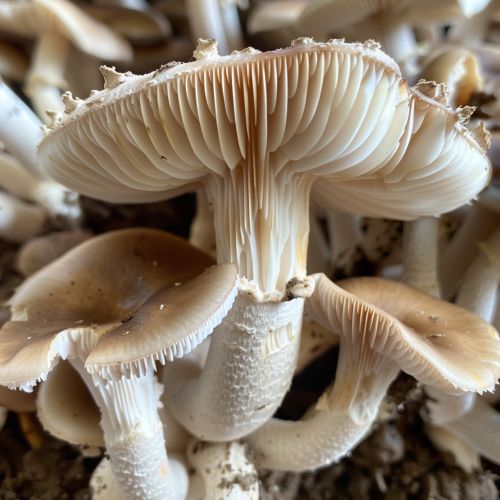Agaricus bisporus
Taxonomy and Naming
The species Agaricus bisporus belongs to the genus Agaricus, which is a part of the family Agaricaceae. The scientific name of the species, Agaricus bisporus, was first described by the German-born mycologist Jacob Emanuel Lange in 1926. The species has several common names, including button mushroom, white mushroom, table mushroom, and champignon mushroom. The term 'bisporus' in the species name refers to the production of two spores per basidium, a characteristic feature of this species.
Description
Agaricus bisporus is a basidiomycete fungus that exhibits a typical mushroom morphology. The cap of the mushroom can range from 2 to 10 cm in diameter, and is initially hemispherical in shape, but flattens with age. The color of the cap can vary from white to brown, depending on the strain and age of the mushroom. The gills are free from the stem, crowded, and initially pink, but turn chocolate brown as the mushroom matures due to the maturation of the spores. The stem is cylindrical and bears a membranous ring.
Distribution and Habitat
Agaricus bisporus is a cosmopolitan species, found in habitats ranging from grasslands to forests, and is widely distributed across North America, Europe, and Australia. It is commonly found growing in rich, organic matter such as compost, manure, and decaying leaves.
Cultivation
Cultivation of Agaricus bisporus is a significant global industry, with the species being the most commonly cultivated edible mushroom worldwide. The cultivation process involves several stages, including composting, spawning, casing, pinning, and cropping. The mushroom is typically grown in controlled environmental conditions to optimize yield and quality.
Nutritional and Culinary Uses
Agaricus bisporus is highly valued for its culinary uses due to its mild flavor and versatile texture. It is rich in proteins, vitamins, and minerals, and low in calories, making it a nutritious food source. It can be consumed raw or cooked, and is used in a variety of dishes including soups, salads, and main courses.
Medicinal Uses and Research
Agaricus bisporus has been studied for potential medicinal properties, including immune system enhancement, anti-cancer effects, and cholesterol-lowering properties. However, more research is needed to fully understand and validate these potential health benefits.
See Also


